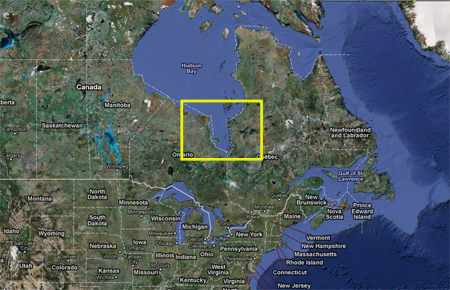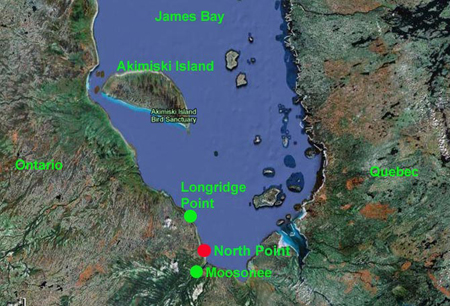We are pleased to this year again post up a guest blog entry from Jean Iron (as relayed by Ron Pittaway) from a remote part of the James Bay region of northern Ontario. Jean is part of a team doing bird surveys and research on the birds that are heading (or have already headed) our way on their way south. Very exciting to find out what is actually out there in this ultra-remote location that is so rarely visited by ornithologists and birders! This entry was originally posted on the Ontario Birds listserve (also where you can find subsequent updates) and we thank Jean and Ron for their permission to reprint it here.
This is Jean Iron's first report via satellite phone for the period 16 -19 July from North Point on the southwestern coast of James Bay, Ontario.

James Bay region of Canada.
North Point is about 25 km (15 miles) north of Moosonee and about 825 km (512 miles) north of Toronto, Ontario. James Bay is the southeastern extension of Hudson Bay reaching deep into eastern Canada between the provinces of Ontario and Quebec south to about 51 degrees north latitude. Its broad tidal flats, wide coastal marshes and islands are of hemispheric importance to southbound shorebirds and waterfowl migrating from the Canadian Arctic. Mark Peck of the Royal Ontario Museum (ROM) in Toronto oversees the surveys of the endangered rufa subspecies of the Red Knot and other shorebirds. Yellow Rails are also being surveyed. Surveys are a cooperative venture of the Ontario Ministry of Natural Resources (OMNR), Canadian Wildlife Service (CWS), Moose Cree First Nation and ROM. This summer there are two main survey sites - Longridge and North Point.

North Point, Longridge Point and Moosonee.
Longridge was also surveyed for Red Knots in 2009 and 2010, but this is the first year for North Point. The crew at North Point is Jean Iron, Doug McRae, Barbara Charlton and Kevin Hannah. The Longridge crew comprises Mark Peck, Roy John, Emily Rondel and Antonio Coral.
GOOSE and SHOREBIRD BREEDING SUCCESS: Early reports from the central and eastern Arctic indicate that Lesser Snow Geese, Cackling Geese, Canada Geese and shorebirds are having a good nesting season.
SHOREBIRDS: 16 species to date. Counts done at high tide. Usually only the high count day for each species is given. Reports below are from North Point unless otherwise noted.
-Black-bellied Plover: 1 adult on 17 July.
-Semipalmated Plover: 5 adults on 18th.
-Greater Yellowlegs: 332 adults on 18th. Greaters nest nearby in?the Hudson Bay Lowland.
-Lesser Yellowlegs: 451 adults on 18th, 3 juveniles on 17th. Lessers nest nearby in the Hudson Bay Lowland.
-Whimbrel: 11 adults on 17th.
-Hudsonian Godwit: 176 adults on 17th.
-Marbled Godwit: 2 adults (pair) seen daily on nesting territory. There is a small isolated breeding population (about 1500 birds) on southern James Bay.
-Ruddy Turnstone: 1 adult on 18th.
-RED KNOT: 35 adults on 18 July. 1 flagged bird (lime green) on 18th probably from Delaware Bay, United States. About 10% of the rufa subspecies is marked. 300 adults at Longridge on 19th.
-Sanderling: 200 adults on 17th.
-Semipalmated Sandpiper: 6355 adults on 18th.
-Least Sandpiper: 27 adults on 18th.
-White-rumped Sandpiper: 3 adults on 17th. Numbers will increase soon.
-Pectoral Sandpiper: 246 adults on 18th.
-Dunlin: 86 adults on 18th. Thousands of Dunlins (subspecies hudsonia) stage in James Bay and undergo prebasic and preformative molts before resuming migration about mid September. This is why Dunlins are very rare south of the subarctic until much later than most shorebirds.
-Wilson's Snipe: 5.
-YELLOW RAIL: Coastal marsh conditions are very dry at North Point and no Yellow Rails heard to date. Conditions also dry at Longridge. However, Ken Abraham who is at Peawanuck on the Hudson Bay Coast reports that Conditions are great here. The pond levels in the interior look good, while some nearer the coast are perhaps drier than average, but not significantly.
OTHER BIRDS: In rough checklist order: Canada Goose. 60 American Black Ducks. 276 Mallards. 1 Northern Pintail. 1 Green-winged Teal. 7 Common Goldeneyes. 5 Common Mergansers. 1 Black Scoter. 1 Common Loon. 1 Double-crested Cormorant. 1 Opsrey. 1 immature Bald Eagle. Northern Harrier and Short-eared Owl: no sightings of these two raptors indicate very low vole and mouse numbers. 76 Sandhill Cranes on 18th. 10 Bonaparte's Gulls (7 adults, 3 second year birds - a few year old birds go to James Bay, but most summer well south of the breeding grounds). 2 Caspian Terns on 18th. 6 Common Terns on 19th. Alder Flycatcher. 10 Least Flycatchers reflecting the aspen forest around camp. Gray Jay. Boreal Chickadee. Ruby-crowned Kinglet. Swainson's Thrush. Brown Thrasher on 18 and 19th; it is a regular vagrant along the coasts of Hudson and James Bays. 8 Cedar Waxwings on 16th. Tennessee Warbler carrying food. Black-and-white Warbler. American Redstart. Ovenbird singing daily at camp. Clay-colored Sparrow, 2 singing near camp, many birders are surprised that this scrubland sparrow breeds around James Bay. Le Conte's Sparrow nest with 4 eggs on 17th. Nelson's Sparrow. Common Grackle on 17th. A few Common Redpolls. 3 Pine Siskins on 18th.
MAMMALS: One Black Bear is near camp, but it is behaving itself. A solar powered electric fence surrounds the food cabin. Around camp there is a Striped Skunk family, a Red Fox family and a young Snowshoe Hare. Vole and mouse numbers are very low. Similar low vole numbers on Akimiski Island, Nunavut.
BUTTERFLIES: Old World Swallowtail, Orange Sulphur, Pink-sided Sulphur, Northern Spring Azure, Atlantis Fritillary, Northern Crescent, White Admiral, Viceroy and Common Ringlet.
ODONATES: Kennedy's Emerald on 17 July.
Aerial photo showing location of North Point in red on southern James Bay.
www.jeaniron.ca/2011/JamesBay2011/NorthPointmap.jpg
Acknowledgements: The crews thank Ken Abraham, Rod Brook and Sarah Hagey of the Ontario Ministry of Natural Resources for logistical support.
Ron Pittaway
Minden, Ontario

